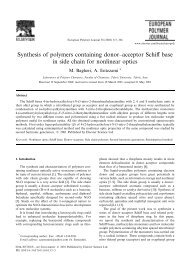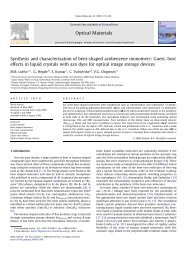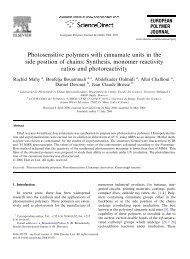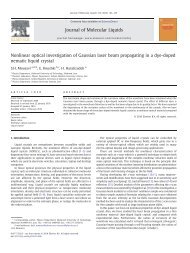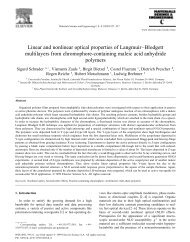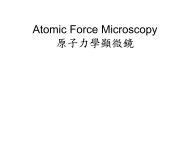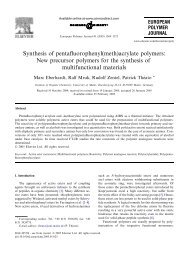Synthesis and characterization of cyclohexene oxide functional ...
Synthesis and characterization of cyclohexene oxide functional ...
Synthesis and characterization of cyclohexene oxide functional ...
Create successful ePaper yourself
Turn your PDF publications into a flip-book with our unique Google optimized e-Paper software.
Fig. 3b shows the 1 H NMR spectrum <strong>of</strong> the poly(<strong>cyclohexene</strong><br />
<strong>oxide</strong>)-polystyrene comb-shaped polymer (Table 2, run 2). Not<br />
only the specific signals <strong>of</strong> PCHO <strong>and</strong> PSt segments are visible,<br />
but also absorptions belonging to the rest <strong>of</strong> the initiator fragment.<br />
In earlier studies on photoinitiated cationic polymerization<br />
using anthracene as a sensitizer it was shown that the electron<br />
transfer, governed by energetic <strong>and</strong> thermodynamic considerations,<br />
was the dominant process. The magnitude <strong>of</strong> the free DG<br />
energy for the electron transfer should have been 10 kJ mol 1 .<br />
The DG value ( 193 kJ mol 1 ) suggests that electron transfer from<br />
singlet anthracene to iodonium ions is quite favorable [37].<br />
Anthracene radical cation or Brønsted acid formed from the hydrogen<br />
abstraction reaction may initiate the polymerization (Scheme<br />
5).<br />
Polystyrene macromonomer (CHO-PSt) was used as a comonomer<br />
in the copolymerization with CHO under similar conditions to<br />
those applied for the polymerization <strong>of</strong> the CHO-PSt macromonomer<br />
itself. Typical results concerning photochemically induced cationic<br />
copolymerization <strong>of</strong> CHO with CHO-PSt macromonomer at<br />
room temperature are shown in Table 3. As can be seen, the concentration<br />
<strong>of</strong> the CHO comonomer influences the composition <strong>of</strong><br />
the graft copolymer. The composition <strong>of</strong> the copolymers PCHO-g-<br />
PSt was determined from 1 H NMR spectra using the integrated<br />
peak ratio <strong>of</strong> the aromatic protons <strong>of</strong> styrene (6.25–7.20 ppm) in<br />
the PSt segment to the OCHCHO protons in the PCHO segment<br />
(3.36 ppm). The content <strong>of</strong> PSt units in a copolymer X (mol %)<br />
was calculated using the following formula:<br />
ðI7:20 6:25=5Þ<br />
XPSt ¼<br />
ðI7:20 6:25=5ÞþðI3:36=2Þ<br />
x<br />
O<br />
CHO<br />
100<br />
where I7.20 6.25 is the integral <strong>of</strong> the aromatic proton signals at<br />
7.20–6.25 ppm, <strong>and</strong> I 3.36 is the integral <strong>of</strong> the OCHCHO proton signals<br />
at 3.36 ppm.<br />
Using CHO-PSt macromonomer as the comonomer allowed for a<br />
rather simple incorporation <strong>of</strong> PSt side chains into poly(<strong>cyclohexene</strong><br />
<strong>oxide</strong>) (PCHO) backbone. In this way, poly(<strong>cyclohexene</strong><br />
H +<br />
hν<br />
350 nm<br />
*<br />
+ Ph2I +<br />
*<br />
<strong>oxide</strong>)-polystyrene graft copolymer with r<strong>and</strong>om sequences <strong>of</strong><br />
the following structure (PCHO-g-PSt) was formed (Scheme 6).<br />
Fig. 3b shows the GPC chromatogram <strong>of</strong> the graft copolymer<br />
(PCHO-g-PSt) that was formed. Notably, no peak pertaining to<br />
the residual homopolymer was detected. The graft copolymer<br />
structures were also assigned by means <strong>of</strong> NMR spectral measurements.<br />
As can be seen the 1 H NMR spectrum <strong>of</strong> the graft copolymer<br />
displays typical signals at 3.36 ppm <strong>of</strong> OCHCHO (PCHO) <strong>and</strong> 7.20–<br />
6.25 ppm <strong>of</strong> aromatic protons (PSt).<br />
4. Conclusions<br />
A new ATRP initiator with a CHO-<strong>functional</strong> group (CHO–Br)<br />
was synthesized by epoxidation <strong>of</strong> 3-cyclohexenylmethyl-2bromopropanoate<br />
in the presence <strong>of</strong> 3-chloroperoxybenzoic acid.<br />
The ATRP <strong>of</strong> styrene monomer using CHO–Br initiator formed a<br />
well-defined PSt macromonomer possessing CHO end groups.<br />
The obtained CHO end-<strong>functional</strong> PSt macromonomer was employed<br />
in photoinitiated cationic (co)polymerization using diphenyliodonium<br />
salt. Photoinitiation <strong>of</strong> cationic polymerizations can<br />
be efficiently achieved by using the iodonium salt at 300 nm as<br />
well as at wavelengths <strong>of</strong> about 350 nm with the aid <strong>of</strong> sensitizers<br />
<strong>and</strong> free radical sources.<br />
Acknowledgements<br />
The authors would like to thank Harran University, the Scientific<br />
Research Council (HÜBAK) <strong>and</strong> Firat University Scientific Research<br />
Projects Unit (FÜBAP) for financial support.<br />
Appendix A. Supplementary data<br />
Supplementary data associated with this article can be found, in<br />
the online version, at doi:10.1016/j.reactfunctpolym.2009.09.010.<br />
8<br />
+ PhI + Ph 9<br />
+ R-H + H + + R 10<br />
+ CHO-PSt PCHO-PSt comb-shaped polymer<br />
Scheme 5. Photolysis <strong>of</strong> anthracene in the presence <strong>of</strong> diphenyliodonium salt.<br />
+<br />
M. Degirmenci et al. / Reactive & Functional Polymers 70 (2010) 28–34 33<br />
Ph2I<br />
y CHO-PSt<br />
hν, 300 nm<br />
+ PF6 -<br />
O<br />
x<br />
O<br />
y<br />
O<br />
PCHO-g-PSt<br />
Scheme 6. <strong>Synthesis</strong> <strong>of</strong> poly(<strong>cyclohexene</strong> <strong>oxide</strong>)-g-polystyrene.<br />
O<br />
n<br />
Br<br />
11<br />
12



